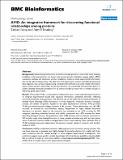| dc.contributor.author | Jiang, Taijiao | |
| dc.contributor.author | Keating, Amy E. | |
| dc.date.accessioned | 2010-09-23T14:23:08Z | |
| dc.date.available | 2010-09-23T14:23:08Z | |
| dc.date.issued | 2005-06 | |
| dc.date.submitted | 2004-12 | |
| dc.identifier.issn | 1471-2105 | |
| dc.identifier.uri | http://hdl.handle.net/1721.1/58681 | |
| dc.description.abstract | Background: Determining the functions of uncharacterized proteins is one of the most pressing problems in the post-genomic era. Large scale protein-protein interaction assays, global mRNA expression analyses and systematic protein localization studies provide experimental information that can be used for this purpose. The data from such experiments contain many false positives and false negatives, but can be processed using computational methods to provide reliable information about protein-protein relationships and protein function. An outstanding and important goal is to predict detailed functional annotation for all uncharacterized proteins that is reliable enough to effectively guide experiments. Results: We present AVID, a computational method that uses a multi-stage learning framework to integrate experimental results with sequence information, generating networks reflecting functional similarities among proteins. We illustrate use of the networks by making predictions of detailed Gene Ontology (GO) annotations in three categories: molecular function, biological process, and cellular component. Applied to the yeast Saccharomyces cerevisiae, AVID provides 37,451 pair-wise functional linkages between 4,191 proteins. These relationships are ~65–78% accurate, as assessed by cross-validation testing. Assignments of highly detailed functional descriptors to proteins, based on the networks, are estimated to be ~67% accurate for GO categories describing molecular function and cellular component and ~52% accurate for terms describing biological process. The predictions cover 1,490 proteins with no previous annotation in GO and also assign more detailed functions to many proteins annotated only with less descriptive terms. Predictions made by AVID are largely distinct from those made by other methods. Out of 37,451 predicted pair-wise relationships, the greatest number shared in common with another method is 3,413. Conclusion: AVID provides three networks reflecting functional associations among proteins. We use these networks to generate new, highly detailed functional predictions for roughly half of the yeast proteome that are reliable enough to drive targeted experimental investigations. The predictions suggest many specific, testable hypotheses. All of the data are available as downloadable files as well as through an interactive website at http://web.mit.edu/biology/keating/AVID. Thus, AVID will be a valuable resource for experimental biologists. | en_US |
| dc.description.sponsorship | National Science Foundation (U.S.) (CAREER award MCB-0347203) | en_US |
| dc.description.sponsorship | Massachusetts Institute of Technology | en_US |
| dc.publisher | BioMed Central Ltd | en_US |
| dc.relation.isversionof | http://dx.doi.org/10.1186/1471-2105-6-136 | en_US |
| dc.rights | Creative Commons Attribution | en_US |
| dc.rights.uri | http://creativecommons.org/licenses/by/2.0 | en_US |
| dc.source | BioMed Central Ltd | en_US |
| dc.title | AVID: An integrative framework for discovering functional relationships among proteins | en_US |
| dc.type | Article | en_US |
| dc.identifier.citation | BMC Bioinformatics. 2005 Jun 01;6(1):136 | en_US |
| dc.contributor.department | Massachusetts Institute of Technology. Department of Biology | en_US |
| dc.contributor.mitauthor | Jiang, Taijiao | |
| dc.contributor.mitauthor | Keating, Amy E. | |
| dc.relation.journal | BMC Bioinformatics | en_US |
| dc.eprint.version | Final published version | en_US |
| dc.identifier.pmid | 15929793 | |
| dc.type.uri | http://purl.org/eprint/type/JournalArticle | en_US |
| eprint.status | http://purl.org/eprint/status/PeerReviewed | en_US |
| dc.date.updated | 2010-09-02T17:51:52Z | |
| dc.language.rfc3066 | en | |
| dc.rights.holder | Jiang et al.; licensee BioMed Central Ltd. | |
| dspace.orderedauthors | Jiang, Taijiao; Keating, Amy E | en |
| dc.identifier.orcid | https://orcid.org/0000-0003-4074-8980 | |
| mit.license | PUBLISHER_CC | en_US |
| mit.metadata.status | Complete | |
